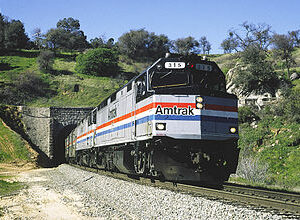Restoring Passenger Rail Service Between Reading and Philadelphia

Berks, Montgomery, and Chester Counties may see a future passenger rail authority. For decades now, a Reading to Philadelphia route has been under discussion. It was first proposed in the late 1990s, but a $2 billion estimate stopped the project in its tracks.
There has not been a passenger rail service between the cities since 1981. Some supporters say it is under serious consideration now because of the Biden administration’s $2 trillion infrastructure bill, which some critics have called a massive step toward socialism.
The proposed option utilizes existing railways – mainly the freight railway owned by Norfolk Southern, but also along some SEPTA tracks– to launch a new passenger train route.
“The value of passenger rail restoration is not so much about a ride to Philadelphia from Reading. It is about opening up western Montgomery and Chester and all of Berks County to the northeast and Mid-Atlantic U.S.,” said Berks County Commissioner Christian Y. Leinbach. “In other words, it’s not about getting there as much as it is about getting people here.”
Rail service declined over the 20th century.
Nearly 42 million people used railways as their primary mode of transportation in the early 1900s. That number consistently decreased as automobiles and auto lobbying became more prominent and commercial aviation flourished. Approximately 9,000 passenger trains were in service in 1950, carrying 50 percent of the traffic between cities; but by 1960, it dropped to 450 trains, transporting 7 percent of intercity traffic.
In 1970, to partially protect the passenger rail system, the Rail Passenger Service Act created America’s railroad, known as “Amtrak.”
Some 91 percent of Americans use automobiles, with environmentalists complaining about problems with widespread usage such as pollution, climate impact, and traffic congestion issues.
“Greenhouse gas emissions from transportation account for about 29 percent of total U.S. greenhouse gas emissions; make it the largest contributor of U.S. GHG emissions. Between 1990 and 2019, GHG emissions in the transportation sector increased more in absolute terms than any other sector,” the Environmental Protection Agency said. But the EPA noted today’s cars are 98 to 99 percent cleaner for most tailpipe pollutants compared to the 1960s.
Some Americans are now trying to move from automobiles to public transportation, including passenger rail. Yet ridership numbers are still minuscule. Amtrak ridership comprises only .1 percent of all passenger travel in the U.S., according to 2020 national transportation statistics from the Department of Transportation.
According to the Urban Reform Institute, even before the massive Biden infrastructure bill, the transportation sector had received billions in subsidies for federal, state, and local governments.
In Amtrak’s 2018 Budget Request to Congress, the federal government earmarked $1.5 billion in Amtrak subsidies. The state subsidies produce $1.7 billion, equaling 26.4 cents per passenger mile.
While some riders share their concerns about rail transportation – including longer transportation times and less reliable service – others have cited concerns of not enough staff.
According to Amtraktrain.com, various voices post their thoughts, and one individual, with a screen name of West Point Engineer, wrote:
“Amtrak suffered from what almost all RR’s go through during downturns. Furlough too many persons. Hindsight tells us it would have been better off to offer part-time work, keeping some benefits, etc. I feel Amtrak is not recruiting enough now. They aren’t enough operating personnel openings to really increase service.”
Meanwhile, the Tri-County Passenger Rail Committee members have Tri-County Passenger Rail Committee has given many presentations about the proposed new train service. Members tout the benefits of passenger rail services in towns like Reading, Pottstown, and Phoenixville could generate $1 billion in property development and increased property values.
As the project gears up, the previous committee will be replaced by the Schuykill River Rail Authority.
Those who support the route may argue that these potential real estate value increases are an essential reason to continue development. Others, however, prefer a financially solvent system and cite how inefficient railroads are, claiming that Amtrak never made a dime in profit in 50 years. A Wall St. Journal opinion piece titled, “Amtrak’s $66 Billion Dollar Ticket: the government can’t run a railroad but it sure can subsidize one,” supports that view.
“The next critical step in the process is the three public hearings in each of the three participating counties,” Leinbach said. “In order to move forward all of these counties will need to approve the formation of the new Schuylkill River Passenger River Authority (SRPRA)…in three years each county will again vet the project and decide if the project still makes sense. This provides a deliberative process that will consider all aspects of impact and do so in a very public and transparent way. We believe this is the right way forward. At this point, I am cautiously optimistic that passenger rail service can be restored.”
The creation of the SRPRA process may be able to extend Amtrak services in the Northeast Corridor, but if Amtrak services are unreliable or frustrating for others, it may not be as beneficial as it could be with a more robust system. Despite the excitement circle around the expansion of Amtrak service, it’s been tempered with a financial concern due to the issues affecting Amtrak in recent years, especially with COVID-19 cutbacks.
Montgomery County residents can comment via email and a hearing is scheduled for Wednesday, April 20 at 2 p.m. in the commissioners boardroom at one Montgomery Plaza located at 425 Swede Street 8th floor in Norristown.
The Chester County Commissioners will also hold a public hearing on the rail proposal during their April 27 meeting. Information about the proposal can be found at www.chesco.org/passengerrail and comments can be submitted via email. The Berks County Commissioners scheduled a public hearing during their meeting for 10 a.m. on April 21.
Follow us on social media: Twitter: @DV_Journal or Facebook.com/DelawareValleyJournal


